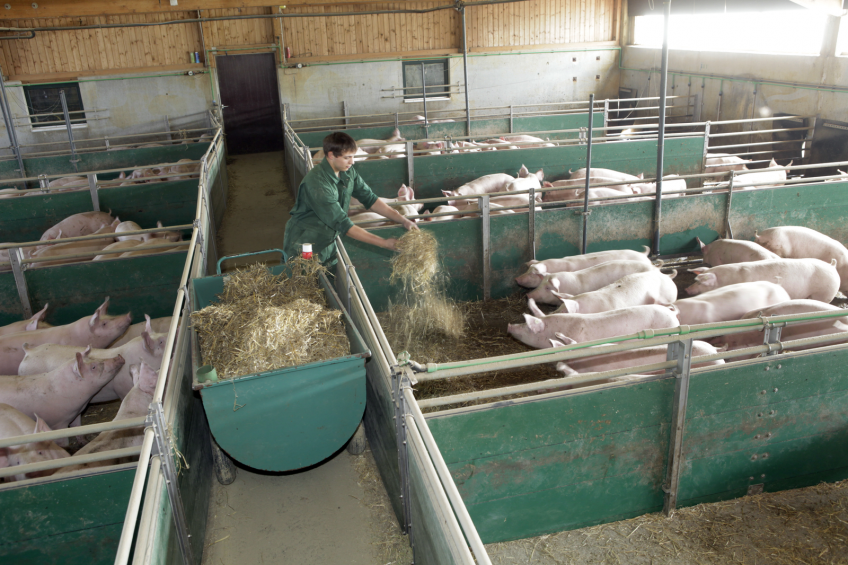Germany’s pig industry: Stable on a high level

At the beginning of this century, Germany’s pig industry grew at a rapid pace. In recent years, however, the growth has levelled off. Rather than opportunities, the country now faces challenges. How to deal with low prices, environmental legislation and animal welfare demands while remaining in business?
German pig meat production and exports have shown remarkable dynamics over the past decade. Most recent data show, however, that this boom phase has levelled off and entered a phase of only low growth rates or even stagnation. In this article, the development of pig meat production and trade will be documented for the period from 2010 to 2015 and an outlook for the coming years will be given.
Statistics: 2010-2015 – slaughtered pigs & imports
Between 2000 and 2010, the number of slaughtered pigs increased from 43.2 million to 58.6 million. This remarkable growth has levelled off, however, as can be seen from Table 1.
Since 2010, pig slaughter has hovered between 58.4 and 59.4 million animals. As in the preceding decade, the high slaughter volume is not based on domestic production of slaughter pigs alone, but also on considerable imports of piglets and slaughter pigs from Denmark and the Netherlands (Table 2).
Of the 15.7 million breeding pigs and piglets which were imported in 2015, 8.3 million (53.1%) came from the Netherlands and 6.7 million (42.8%) from Denmark. The import of slaughter pigs decreased from 5.5 million in 2010 to 4.4 million in 2015 or by 20.5%. This is mainly due to a sharp reduction of the imports from Denmark and the Netherlands.
Imports from Denmark decreased from over 723,000 in 2010 pigs to only 150,000 in 2015 or by almost 80%, those from the Netherlands from 4.4 million to 3.7 million or by 17.5%. This documents the recovering swine industry in both countries from several years of stagnation.
Pig meat production up by 200,000 tonnes
Pig meat production increased by 200,000 tonnes in the analysed time-frame or by 4.2%.
The data in Table 3 reveals, however, that the production volume has been more or less stable between 2011 and 2015. This reflects the development of the per capita consumption of meat. From Table 4 one can easily see that the per capita consumption of pig meat decreased by 3.0 kg between 2010 and 2015. Parallel to this downward trend, the self-sufficiency rate increased from 110.0% to 120.1%.
This had, as will be shown later, impacts on the export and import volumes. In contrast to pig meat, the per capita consumption of poultry meat grew by 0.9 kg. The self-sufficiency rate for this meat type increased from 105.9% to 112.5%. The remarkable growth of poultry meat production resulted in a considerable increase of the export volume.
Germany’s pig meat trade
The decline in the per capita consumption of pig meat and the very stable production volume resulted in increasing exports and decreasing imports. Between 2010 and 2015, Germany’s pig meat exports grew by 330,000 tonnes or 12.8% and reached a volume of 2.9 million tonnes. It was a continuous upward trend which documents that the main exporting companies were able to find new markets for their products. In 2015, the ten leading countries of destination shared 73.1% in the total export volume (Table 5), the leading five countries 50.6%.
The 3 main markets were:
Italy
China
The Netherlands.
Exports to China
In particular, exports to China developed remarkably. In 2013, the East Asian country imported about 198,000 tonnes of pig meat from Germany; 2 years later, the volume was 180,000 tonnes more. Recent data shows that in 2016 the export volume will grow considerably again.
Fall in domestic demand
Because of the lower per capita consumption, the domestic demand decreased, resulting in falling import volumes. In 2015, pig meat imports were 33,000 tonnes or 2.7% lower than in 2010. Pig meat was mainly imported from other EU member countries (Table 6). The 3 leading countries of origin shared 71.2% in the total import volume. With the exception of Switzerland, which contributed 1.7% to the German imports, all top listed countries were EU member countries with Denmark, Belgium and the Netherlands in the 3 leading positions.
Developing new markets
A comparison of the export and import volumes shows (Table 7) that the trade surplus increased by 360,000 tonnes or 26.6% between 2010 and 2015. This again documents the success of the German pig meat producers in developing new markets despite a stable production volume and a decreasing domestic demand by 240,000 tonnes or 5.4%.
Future challenges for Germany’s swine industry
The German swine industry is confronted with several challenges which demand immediate action. It is obvious that new regulations concerning the protection of the environment and animal welfare have led to a considerable increase of the production costs. It can be expected that this trend will continue in the coming years. It is only because of lower feed costs that the financial losses have not caused a more dramatic structural change. Between November 2010 and November 2015 – the number of pig farms decreased from 32,900 to only 25,700 or by 22%.
It can be expected that because of the lasting low market prices for piglets and slaughter pigs, the sectoral concentration in pig husbandry will continue. Between 2013 and 2015, the average price which farmers in Lower Saxony, the centre of Germany’s pig production, received fell from €1.70/kg to €1.39/kg and reached a long-time low in February 2015 between €1.24/kg and €1.27/kg for class E slaughter pigs.
It was not before June 2016 that prices climbed again to €1.50/kg because of increasing exports to China and a growing domestic demand during the grill season. Low prices, new regulations regarding environmental protection and animal welfare may accelerate the future loss of pig farms. How these challenges can be met, is being discussed intensively in Germany. One way out of this critical economic situation could be a stronger integration of the pig farmers, either horizontally, for example in co-operatives, or vertically, as is the case in poultry meat production.
* The author is emeritus professor and scientific director of the Science and Information Centre Sustainable Poultry Production, University of Vechta. He can be reached by e-mail at hwindhorst@wing.uni-vechta.de

Germany at a glance
Germany is one of the leading countries with regards to pigs in the European Union. Both pig production and pig consumption are among the top in Europe. Only in 2015, Spain overtook Germany as the largest country in terms of pig numbers, largely because of a strong growth in Spain in recent years. In terms of pig meat, Germany is still Europe’s largest, with in 2015 5.56 million tonnes of pork produced, according to Eurostat figures. The majority of pigs can be found in Germany in the states of Lower Saxony and North Rhine Westphalia, both in the country’s north west. In addition, ever since the reunification of Germany, large pig projects have been started up in the relatively lower densely populated areas of what used to be Eastern Germany.











